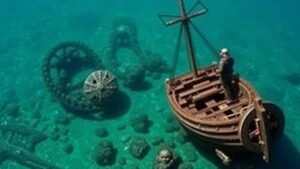Mining Early Steamship Records for Nautical Equipment Relic Clues
Introduction
The application of early steamship records as a resource for uncovering nautical equipment relics has gained significant interest in maritime archaeology. This research article aims to explore the methodologies for mining these historical documents to derive valuable information regarding the design, function, and technology of nautical equipment used during the steamship era. By examining specific case studies, the article delineates the potential for utilizing early steamship data to enhance our understanding of maritime history and the evolution of nautical technology.
Historical Context of Early Steamships
Early steamships emerged in the early 19th century, transforming maritime transportation and trade. first successful steam-powered vessel, the Clermont, was launched by Robert Fulton in 1807. By the 1830s, steamships had proliferated in American and European waters, facilitating faster and more reliable shipping routes. In the United States, records from steaming pioneers like the Great Western Railway and the Cunard Line document the rapid advancement in steam technology.
Significance of Nautical Equipment
Nautical equipment during the steamship era comprised a variety of instruments and tools essential for navigation, safety, and operational efficiency. Notable equipment included:
- Steam engines and boilers
- Compasses and chronometers
- Life-saving devices such as life buoys and flares
- Signals and communication equipment like flags and horns
Investigating these relics provides insights into maritime engineering practices and safety protocols of the time.
Methodologies for Mining Steamship Records
Mining steamship records involves a systematic approach reminiscent of both historical research and data analysis. The preservation of archival records often includes manifests, logs, blueprints, and inspection documents. The following methodologies illustrate effective strategies for extracting informative data regarding nautical equipment relics from steamship records.
Archival Research
Archival research focuses on examining primary sources stored in libraries, maritime museums, and online databases. For example, the Library of Congress in Washington, D.C., holds extensive collections of steamship logs documenting voyages and events crucial for analyzing equipment used in actual sailing conditions.
Data Analysis Techniques
Data analysis entails organizing and synthesizing the information obtained from historical records. Researchers often utilize software like qualitative data analysis (QDA) tools to systematically code entries for various equipment types. This approach can yield quantifiable data, allowing for trends to be discerned in the usage and evolution of specific nautical implements.
Case Studies of Successful Data Mining
The SS Great Eastern
The SS Great Eastern, launched in 1858 by Isambard Kingdom Brunel, serves as an exemplary case study. Documentation from the National Maritime Museum details the ships innovative equipment, including its enormous size, dual-fuel engines, and pioneering safety measures.
Subsequent research into the nautical equipment used aboard the Great Eastern revealed design advancements in boiler technology and life-saving equipment, indicating an evolution in maritime safety practices at the time.
The RMS Titanic
The RMS Titanic, tragically sunk in 1912, offers another poignant example of the value of steamship records. Detailed documentation from the Titanics construction, including engineering blueprints and safety inspection records, elucidates the advanced lifeboat systems and wireless communication technologies implemented.
Through meticulous analysis of these records, researchers have identified significant clues about safety lapses and design flaws that contributed to the disaster, highlighting the importance of diligent record-keeping in maritime history.
Real-World Applications and Implications
The insights garnered from early steamship records extend beyond academic interest, impacting contemporary maritime practices. The study of historical equipment has informed current safety regulations and engineering designs in modern vessels. Researchers advocate for increased investment in the preservation and study of these records to better inform maritime safety protocols and heritage conservation.
Conclusion
The mining of early steamship records for clues regarding nautical equipment relics represents a fruitful interdisciplinary endeavor. By integrating archival research and data analysis methodologies, scholars can reconstruct a clearer picture of maritime practices during the steamship era. The implications of this research impact both historical understanding and present-day maritime safety practices. Future studies should prioritize continued exploration of untouched archives and the adoption of advanced data collection techniques to enhance maritime archaeological research.



